Related Research Articles
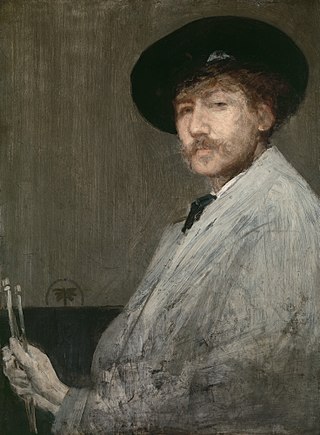
James Abbott McNeill Whistler was an American painter in oils and watercolor, and printmaker, active during the American Gilded Age and based primarily in the United Kingdom. He eschewed sentimentality and moral allusion in painting and was a leading proponent of the credo "art for art's sake".

An artistamp or artist's stamp is a postage stamp-like art form used to depict or commemorate any subject its creator chooses. Artistamps are a form of Cinderella stamps in that they are not valid for postage, but they differ from forgeries or bogus Illegal stamps in that typically the creator has no intent to defraud postal authorities or stamp collectors.

The postal and philatelic history of Canada concerns postage of the territories which have formed Canada. Before Canadian confederation, the colonies of British Columbia and Vancouver Island, Prince Edward Island, Nova Scotia, New Brunswick and Newfoundland issued stamps in their own names. The postal history falls into four major periods: French control (1604–1763), British control (1763–1841), colonial government control (1841–1867), and Canada, since 1867.

Gilbert Stuart was an American painter born in the Rhode Island Colony who is widely considered one of America's foremost portraitists. His best-known work is an unfinished portrait of George Washington, begun in 1796, which is usually referred to as the Athenaeum Portrait. Stuart retained the original and used it to paint scores of copies that were commissioned by patrons in America and abroad. The image of George Washington featured in the painting has appeared on the United States one-dollar bill for more than a century and on various postage stamps of the 19th century and early 20th century.

John Trumbull was an American painter and military officer best known for his historical paintings of the American Revolutionary War, of which he was a veteran. He has been called the "Painter of the Revolution". Trumbull's Declaration of Independence (1817), one of his four paintings that hang in the United States Capitol rotunda, is used on the reverse of the current United States two-dollar bill.

Thomas Richman Blackshear II is an African-American artist whose paintings adorn many Evangelical churches. He is also a sculptor and a designer of stamps and ornaments, often with African American or Western themes.

Edwin White was an American painter.

Declaration of Independence is a 12-by-18-foot oil-on-canvas painting by the American artist John Trumbull depicting the presentation of the draft of the Declaration of Independence to Congress. It was based on a much smaller version of the same scene, presently held by the Yale University Art Gallery. Trumbull painted many of the figures in the picture from life, and visited Independence Hall to depict the chamber where the Second Continental Congress met. The oil-on-canvas work was commissioned in 1817, purchased in 1819, and placed in the United States Capitol rotunda in 1826.

George Morrison was an Ojibwe abstract painter and sculptor from Minnesota. His Ojibwe name was Wah Wah Teh Go Nay Ga Bo. Morrison's work is associated with the Abstract Expressionist movement in the United States.
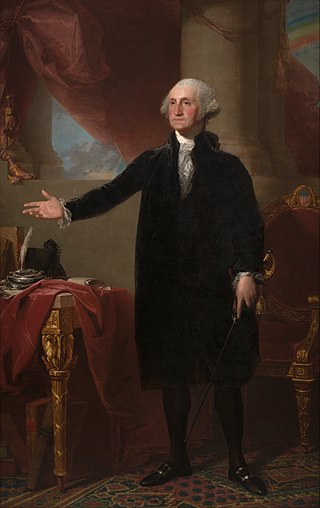
Beginning with painter Gilbert Stuart's portrait of George Washington, it has been tradition for the president of the United States to have an official portrait taken during their time in office, most commonly an oil painting. This tradition has continued to modern times, although since the adoption of photography as a widely used and reliable technology, the official portrait may also be a photograph.
Tim O'Brien is an American artist who works in a realistic style. His illustrations have appeared on the covers and interior pages of magazines such as Time, Rolling Stone, GQ, Esquire, National Geographic, Der Spiegel, and others. His illustrations are also used by the US Postal Service for postage stamps.
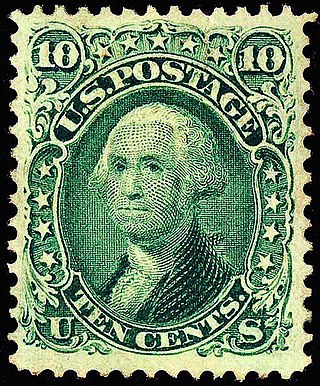
Presidents of the United States have frequently appeared on U.S. postage stamps since the mid-19th century. The United States Post Office Department released its first two postage stamps in 1847, featuring George Washington on one, and Benjamin Franklin on the other. The advent of presidents on postage stamps has been definitive to U.S. postage stamp design since the first issues were released and set the precedent that U.S. stamp designs would follow for many generations.

The Regular Issues of 1922–1931 were a series of 27 U.S. postage stamps issued for general everyday use by the U.S. Post Office. Unlike the definitives previously in use, which presented only a Washington or Franklin image, each of these definitive stamps depicted a different president or other subject, with Washington and Franklin each confined to a single denomination. The series not only restored the historical tradition of honoring multiple presidents on U.S. Postage but extended it. Offering the customary presidential portraits of the martyred Lincoln and Garfield, the war hero Grant, and the founding fathers Washington and Jefferson, the series also memorialized some of the more recently deceased presidents, beginning with Hayes, McKinley, Cleveland and Roosevelt. Later, the deaths of Harding, Wilson and Taft all prompted additions to the presidential roster of Regular Issue stamps, and Benjamin Harrison's demise (1901) was belatedly deemed recent enough to be acknowledged as well, even though it had already been recognized in the Series of 1902. The Regular Issues also included other notable Americans, such as Martha Washington and Nathan Hale—and, moreover, was the first definitive series since 1869 to offer iconic American pictorial images: these included the Statue of Liberty, the Capitol Building and others. The first time (1869) that images other than portraits of statesmen had been featured on U.S. postage, the general public disapproved, complaining that the scenes were no substitute for images of presidents and Franklin. However, with the release of these 1922 regular issues, the various scenes—which included the Statue of Liberty, the Lincoln Memorial and even an engraving of an American Buffalo—prompted no objections. To be sure, this series presented pictorial images only on the higher-value stamps; the more commonly used denominations, of 12 cents and lower, still offered the traditional portraits.
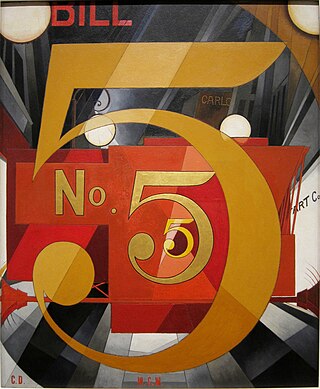
I Saw the Figure 5 in Gold, also known as The Figure 5 in Gold, is a 1928 painting by American artist Charles Demuth. It has been described as influenced by Futurism and Cubism.
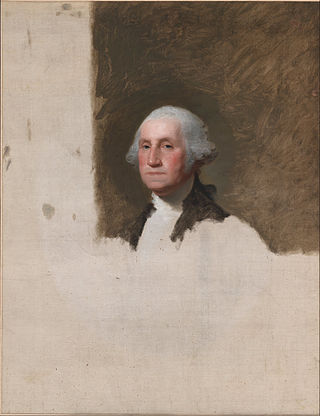
The Athenaeum Portrait, also known as The Athenaeum, is an unfinished painting by Gilbert Stuart of United States President George Washington. Created in 1796, it is Stuart's most notable work. The painting depicts Washington at age 64, about three years before his death, on a brown background. It served as the model for the engraving that would be used for Washington's portrait on the United States one-dollar bill.

The history of Virginia through the colonial period on into contemporary times has been depicted and commemorated on postage stamps accounting for many important personalities, places and events involving the nation's history. Themes are particularly rich in early American and new nation history, historical landmarks, and Virginia-born presidents.
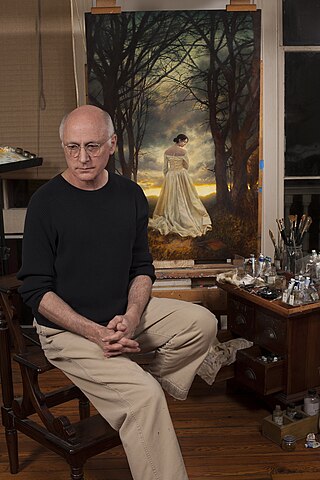
Michael J. Deas is an American realist painter and illustrator whose work is known for both its technical skill and "a growing sense of grace and serenity". He is cited in Roger and Walt Reed's definitive history of illustration, The Illustrator in America. He works primarily in oils and graphite. Deas began creating illustrations while studying fine art in New York during the 1970s. He has since gone on to paint six covers for Time magazine and 25 stamps for the US Postal Service, including likenesses of Tennessee Williams (1995), Marilyn Monroe (1995), F. Scott Fitzgerald (1996), Meriwether Lewis (2004), George H. W. Bush (2019) and Ruth Bader Ginsburg (2023). Other notable works include the US poster for Werner Herzog's film, Aguirre, the Wrath of God, and the cover art for the 20th-anniversary edition of Anne Rice's book, Interview with the Vampire. His most recognizable work is his luminous redesign of the Columbia Pictures logo, painted [with oils] in 1991 and in continuous use since that time.
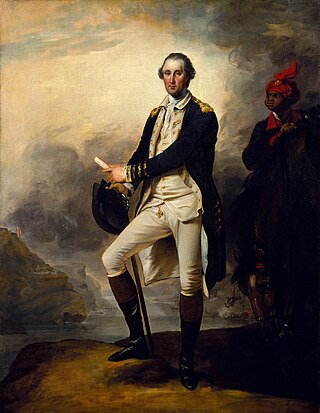
George Washington, also entitled George Washington and William Lee, is a full-length portrait in oil painted in 1780 by the American artist John Trumbull during the American Revolutionary War. General George Washington stands near his enslaved servant William Lee, overlooking the Hudson River in New York, with West Point and ships in the background. Trumbull, who once served as an aide-de-camp to Washington, painted the picture from memory while studying under Benjamin West in London. He finished it before his arrest for high treason in November. The portrait, measuring 36 in × 28 in, is on view in Gallery 753 at the Metropolitan Museum of Art in New York City. Originally in the possession of the de Neufville family of the Netherlands, it was bequeathed to the museum by Charles Allen Munn in 1924.

General George Washington at Trenton is a large full-length portrait in oil painted in 1792 by the American artist John Trumbull of General George Washington at Trenton, New Jersey, on the night of January 2, 1777, during the American Revolutionary War. This is the night after the Battle of the Assunpink Creek, also known as the Second Battle of Trenton, and before the decisive victory at the Battle of Princeton the next day. The artist considered this portrait "the best certainly of those which I painted." The portrait is on view at the Yale University Art Gallery in New Haven, Connecticut, an 1806 gift of the Society of the Cincinnati in Connecticut. It was commissioned by the city of Charleston, South Carolina, but was rejected by the city, resulting in Trumbull painting another version.
George Hunt was a Southern American artist, best known for his portraits of Blues musicians and illustrations for Blues Festivals, which ended up in many private collections in addition to galleries, museums, and the walls of Memphis businesses. He was primarily a painter, though he added collage highlights to some of his acrylic paintings that gave a distinctive three dimensionality and texture to the works. For 28 years, Hunt created the official poster for the Memphis in May Beale Street Music Festival. Many people have seen his work or might even own it on a poster or T-shirt without knowing his name. He was selected to be the "official artist" of 2003's "Year of the Blues," a congressionally endorsed effort to increase appreciation of the Blues as one of America's great contributions to international arts culture, and toured to many places promoting the celebration.
References
- ↑ Dunn, John F. (September 21, 1986). "STAMPS; AMERICAN SCHOLARS ARE HONORED". The New York Times. Retrieved September 30, 2023.
- ↑ "George W. Bush". National Portrait Gallery. July 6, 1946. Retrieved September 30, 2023.
- ↑ Shattuck, Ben (December 9, 2014). "Painting the President". The Morning News. Retrieved September 30, 2023.
- 1 2 3 4 "Robert A. Anderson Master Artist". Portraits Inc. Retrieved September 30, 2023.
- 1 2 3 Grant, Daniel (July 14, 2005). "Presidential Portraits". artnet Magazine. Retrieved October 1, 2023.
- ↑ Fashion 86 Staff (December 12, 1986). "The Breck Girl--that serene and frequently blond..." Los Angeles Times. Retrieved September 30, 2023.
{{cite web}}: CS1 maint: numeric names: authors list (link) - ↑ "Artist Biographies". National Postal Museum. July 1, 2020. Retrieved September 30, 2023.
- ↑ Cruice, Valerie (November 9, 2003). "The Painter And the President". The New York Times. Retrieved September 30, 2023.
- ↑ Gambino, Megan (January 7, 2009). "George W. Bush's Portrait at National Portrait Gallery". Smithsonian Magazine. Retrieved October 1, 2023.